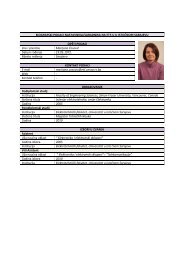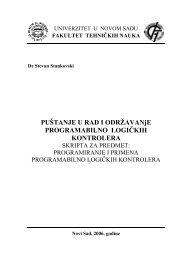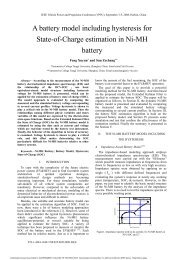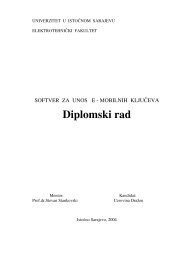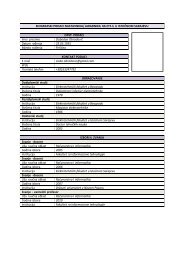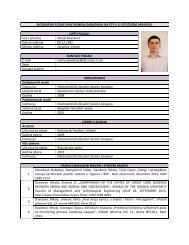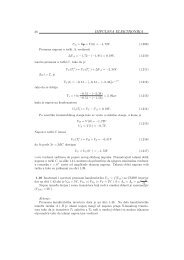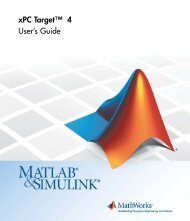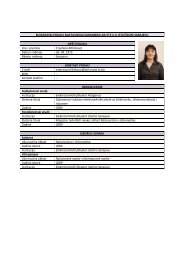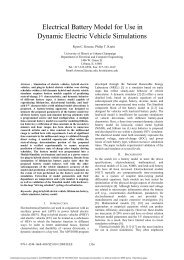tLI.&&~I- -('I Reec\a"";lhReacts IoI1th0 sulfuric ootd sulfate ;ons.c .c"'form 1 .... to form loade.e. s ulfato. Must sulfate. Pbs uppl y .lootronssupplios Iwend 10 Ionposlt1vepositive H 2SO 4 chergno end1 .... eloctrode""--- H2O 1. left ""---IIOQ8tiveFigure 1: Lead-<strong>acid</strong> <strong>battery</strong> [6].MODELING OF THE LEAD-ACID BATTERYThe <strong>lead</strong>-<strong>acid</strong> <strong>battery</strong> represents a fundamental and mainelement in <strong>the</strong> renewable energy systems and in <strong>the</strong>hybrid vehicles. Therefore, it is necessary to study <strong>the</strong><strong>model</strong>ing <strong>of</strong> this type <strong>of</strong> batteries. In fact, very bigquantities <strong>of</strong> <strong>model</strong>s exist, from <strong>the</strong> simplest, containingimpedance placed in series with a voltage source, to <strong>the</strong>most complex. In general, <strong>the</strong>se <strong>model</strong>s represent <strong>the</strong><strong>battery</strong> like an electric circuit composed <strong>of</strong> resistances,capacities and o<strong>the</strong>r elements, constant or variable(function <strong>of</strong> <strong>the</strong> temperature or <strong>the</strong> State Of Charge SOCthat gives an idea on <strong>the</strong> quantity <strong>of</strong> active substance)[7],[8].The simplified <strong>model</strong>The simplest <strong>model</strong> <strong>of</strong> a <strong>lead</strong>-<strong>acid</strong> <strong>battery</strong> is composed <strong>of</strong>a voltage source placed in series with impedance (Fig. 2).,...Lr------Figure 2: Lead-<strong>acid</strong> <strong>battery</strong> simplest <strong>model</strong>.The main problem <strong>of</strong> this <strong>model</strong> is that <strong>the</strong> two elementsE(p) and Z(p) must be at least function <strong>of</strong> <strong>the</strong> State OfCharge (SOC) and <strong>of</strong> <strong>the</strong> <strong>battery</strong>'s temperature e [9,10].The improvement <strong>of</strong> <strong>the</strong> simple <strong>model</strong> takes place whi<strong>lead</strong>ding a parasitic branch in parallel (Figure 3).I,... (C1SOC')Figure 3: Lead-<strong>acid</strong> <strong>battery</strong> general <strong>model</strong>.In fact, <strong>the</strong> parasitic branch represents <strong>the</strong> irreversiblereactions that take place in <strong>the</strong> <strong>battery</strong> as for example <strong>the</strong>electrolysis <strong>of</strong> water that occurs at <strong>the</strong> end <strong>of</strong> <strong>the</strong> chargingprocess, especially in <strong>the</strong> case <strong>of</strong> overcharge. In thisbranch an Ip current circulates. The charge stocked in <strong>the</strong><strong>battery</strong> is only joined to 1m (current <strong>of</strong> <strong>the</strong> main branch, inamperes). A part <strong>of</strong> <strong>the</strong> total current I, which is <strong>the</strong> Ipcurrent, is a lost current and cannot be restored.The third order <strong>model</strong> [11]The <strong>model</strong> is consisted <strong>of</strong> two main parts: a main branchwhich approximated <strong>the</strong> <strong>battery</strong> dynamics under mostconditions, and a parasitic branch which accounted for <strong>the</strong><strong>battery</strong> behavior at <strong>the</strong> end <strong>of</strong> a charge. The main branchis formed <strong>of</strong> a R/C block placed in series with a resistance(Figure 4). All elements <strong>of</strong> figure 4 are functions <strong>of</strong> <strong>the</strong>State Of Charge (SOC), <strong>the</strong> charging/discharging currentsand <strong>the</strong> temperature <strong>of</strong> <strong>the</strong> electrolyte 9.EmNFigure 4: Lead-<strong>acid</strong> <strong>battery</strong> third order <strong>model</strong>.where:• Em was <strong>the</strong> main branch voltage,• R1 was <strong>the</strong> main branch resistance,• C1 was <strong>the</strong> main branch capacitance,• R2 was <strong>the</strong> main branch resistance,• I 01pn) was <strong>the</strong> Parasitic branch current,• Ro was <strong>the</strong> Terminal resistance.RO,...L+Main branch voltage (Em)Equation 1 approximated <strong>the</strong> internal electro-motive force(emf), or open-circuit voltage <strong>of</strong> one cell. The emf valuewas assumed to be constant when <strong>the</strong> <strong>battery</strong> was fullycharged. The emf varied with temperature and state <strong>of</strong>charge (SOC):Em = EmO - KE .(273 + 9)(1-SOC) (1)where:• Em was <strong>the</strong> open-circuit voltage (EMF) in volts,• Emo was <strong>the</strong> open-circuit voltage at full charge in volts,• KE was a constant in volts 1 DC,• 9 was electrolyte temperature in DC,• SOC was <strong>battery</strong> state <strong>of</strong> charge.Main branch resistance R1Equation 2 approximated a resistance in <strong>the</strong> main branch<strong>of</strong> <strong>the</strong> <strong>battery</strong>. The resistance varied with depth <strong>of</strong> charge,a measure <strong>of</strong> <strong>the</strong> <strong>battery</strong>'s charge adjusted for <strong>the</strong>discharge current. The resistance increased exponentiallyas <strong>the</strong> <strong>battery</strong> became exhausted during a discharge.v978-1-4244-1641-7/08/$25.00 ©2008 IEEEAuthorized licensed use limited to: GOVERNMENT COLLEGE OF TECHNOLOGY. Downloaded on December 31, 2009 at 04:54 from IEEE Xplore. Restrictions apply.
where:• R1 was a main branch resistance in Ohms,• R10 was a constant in Ohms,• DOC was <strong>battery</strong> depth <strong>of</strong> charge.(2)Main branch capacitance C1Equation 3 approximated a capacitance (or time delay) in<strong>the</strong> main branch. The time constant <strong>model</strong>ed a voltagedelay when <strong>battery</strong> current changed.C 1 =l (3)RIwhere:• C1 was a main branch capacitance in Farads,• T1 was a main branch time constant in seconds,• R1 was a main branch resistance in Ohms.Main branch resistance R2Equation 4 approximated a main branch resistance. Theresistance increased exponentially as <strong>the</strong> <strong>battery</strong> state <strong>of</strong>charge increased.The resistance also varied with <strong>the</strong> current flowing through<strong>the</strong> main branch. The resistance primarily affected <strong>the</strong><strong>battery</strong> during charging. The resistance became relativelyinsignificant for discharge currents:Note that while <strong>the</strong> constant Gpo was measured in units <strong>of</strong>seconds, <strong>the</strong> magnitude <strong>of</strong> Gpo was very small, on <strong>the</strong>order <strong>of</strong> 10-12 seconds.I p =V PN. G po·exp + p (6)VpoSf[VPN /(t p .s+l) A (1-~)lwhere:• Ip was <strong>the</strong> current loss in <strong>the</strong> parasitic branch,• VPN was <strong>the</strong> voltage at <strong>the</strong> parasitic branch,• GpO was a constant in seconds,• Tp was a parasitic branch time constant in seconds,• Vpo was a constant in volts,• Ap was a constant,• 8 was <strong>the</strong> electrolyte temperature in DC,• 8t was <strong>the</strong> electrolyte freezing temperature in DC.Some definitionsExtracted charge QeEquation 7 tracked <strong>the</strong> amount <strong>of</strong> charge extracted from<strong>the</strong> <strong>battery</strong>. The charge extracted from <strong>the</strong> <strong>battery</strong> was asimple integration <strong>of</strong> <strong>the</strong> current flowing into or out <strong>of</strong> <strong>the</strong>main branch. The initial value <strong>of</strong> extracted charge wasnecessary for simulation purposes.tQe(t) = Qe_init + f-Im(t).dt(7)owhere:• R2 was a main branch resistance in Ohms,• R20 was a constant in Ohms,• A21 was a constant,• A22 was a constant,• Em was <strong>the</strong> open-circuit voltage (EMF) in volts,• SOC was <strong>the</strong> <strong>battery</strong> state <strong>of</strong> charge,• 1m was <strong>the</strong> main branch current in Amps,• 1* was <strong>the</strong> nominal <strong>battery</strong> current in Amps.(4)Total capacity CEquation 8 approximated <strong>the</strong> capacity <strong>of</strong> <strong>the</strong> <strong>battery</strong> basedon discharge current and electrolyte temperature.However, <strong>the</strong> capacity dependence on current was only fordischarge. During charge, <strong>the</strong> discharge current was setequal to zero in Equation 8 for <strong>the</strong> purposes <strong>of</strong> calculatingtotal capacity.C(I,9) = K,.C,' , {l-~)'1+(Kc-l~I~) Sf(8)Terminal resistance ROEquation 5 approximated a resistanceseen at <strong>the</strong> <strong>battery</strong>terminals. The resistance was assumed constant at alltemperatures, and varied with <strong>the</strong> state <strong>of</strong> charge:Ro = Roo [1 + Ao(I-S0C)] (5)where:• Ro was a resistance in Ohms• Roo was <strong>the</strong> value <strong>of</strong> RO at SOC=1 in Ohms• Ao was a constant• SOC was <strong>the</strong> <strong>battery</strong> state <strong>of</strong> chargeParasitic branch current IpEquation 6 approximated <strong>the</strong> parasitic loss current whichoccurred when <strong>the</strong> <strong>battery</strong> was being charged. The currentwas dependent on <strong>the</strong> electrolyte temperature and <strong>the</strong>voltage at <strong>the</strong> parasitic branch. The current was very smallunder most conditions, except during charge at high SOC.where:• Kc was a constant,• Co* was <strong>the</strong> no-load capacity at O°C in Amp-seconds,• 8 was <strong>the</strong> electrolyte temperature in DC,• I was <strong>the</strong> discharge current in Amps,• I" was <strong>the</strong> nominal <strong>battery</strong> current in Amps,• ~ and E were a constant.State Of Charge (SOC) and Depth Of Charge (DOC)Equations 9 and 10 calculated <strong>the</strong> SOC and DOC as afraction <strong>of</strong> available charge to <strong>the</strong> <strong>battery</strong>'s total capacity.State <strong>of</strong> charge measured <strong>the</strong> fraction <strong>of</strong> charge remainingin <strong>the</strong> <strong>battery</strong>:SOC =1-Q eC(O,S)(9)978-1-4244-1641-7/08/$25.00 ©2008 IEEEAuthorized licensed use limited to: GOVERNMENT COLLEGE OF TECHNOLOGY. Downloaded on December 31, 2009 at 04:54 from IEEE Xplore. Restrictions apply.



